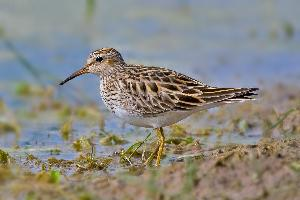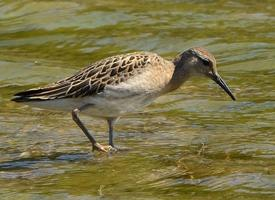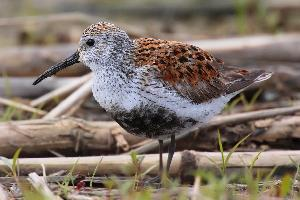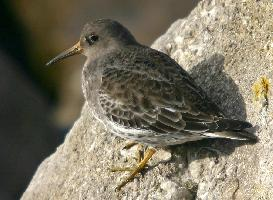
Popis zvířete
The Purple Sandpiper, scientifically known as Calidris maritima, is a small wading bird that belongs to the Scolopacidae family, which is renowned for its diverse species of sandpipers, snipes, and their kin. Despite its common name, the bird is not predominantly purple but exhibits a rather subtle purplish-brown hue in its non-breeding plumage, which is more apparent under certain lighting conditions. This bird is a captivating subject of study for ornithologists and a delightful sight for birdwatchers.The Purple Sandpiper is a medium-sized sandpiper, measuring about 20-22 cm in length, with a wingspan ranging from 42 to 46 cm. It possesses a stocky build, with a relatively short neck and a small head, which gives it a distinctive profile compared to other sandpipers. The bird's bill is short, stout, and slightly down-curved, designed perfectly for foraging its diverse diet. Its legs are of a bright yellow-orange hue, providing a stark contrast against its darker plumage, which is a mix of gray, brown, and purple tones.
One of the most fascinating aspects of the Purple Sandpiper is its habitat. Unlike many other sandpipers that prefer warmer climates, the Purple Sandpiper thrives in colder, northern regions. It breeds in the Arctic tundras of Canada, Greenland, Scandinavia, and Russia, often nesting on the ground among rocks or in mossy areas. Its breeding plumage is a beautiful sight, showcasing richer and more pronounced colors, with dark, dense streaks and spots over a lighter background, which provides excellent camouflage against the Arctic landscape.
During the winter months, the Purple Sandpiper migrates south but remains in relatively cold coastal areas, often being found along rocky shorelines, jetties, and piers of the North Atlantic coast. It is a hardy species, adept at navigating the harsh conditions of its wintering grounds, where it can be seen foraging among the waves, picking small invertebrates from the seaweed and rocks. Its diet is varied, consisting of insects, crustaceans, mollusks, and sometimes small fish, which it adeptly captures with its specialized bill.
One of the most remarkable behaviors of the Purple Sandpiper is its resilience and adaptability. It is known for its ability to withstand cold temperatures and rough seas, often seen feeding energetically amidst snow, ice, and crashing waves, a testament to its hardiness. The bird's social behavior is equally interesting; it tends to form small flocks during winter, showing a sense of community and cooperation among individuals.
Conservation-wise, the Purple Sandpiper is currently classified as Least Concern by the International Union for Conservation of Nature (IUCN), indicating that it does not face immediate threats of extinction. However, like many species, it is vulnerable to habitat loss, pollution, and climate change, which could impact its breeding and wintering grounds. Conservation efforts aimed at preserving coastal habitats and mitigating climate change are essential to ensure the continued survival of this remarkable species.
In conclusion, the Purple Sandpiper is a unique and fascinating bird, embodying the rugged beauty of the northern landscapes it inhabits. Its resilience, striking plumage, and intriguing behaviors make it a cherished subject among bird enthusiasts and a species worthy of admiration and protection.
Mapa výskytu
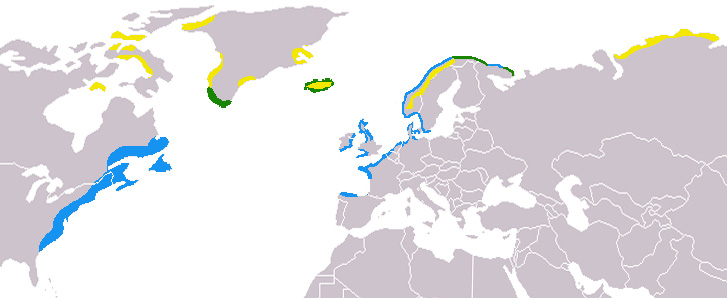
Podobná zvířata
Nové fotografie zvířat
Top 10 zvířat
- Elephant hawk moth (Deilephila elpenor)
- Common house mosquito (Culex pipiens)
- Fruit fly (Drosophila melanogaster)
- Australian box jelly (Chironex fleckeri)
- Wasp spider (Argiope bruennichi)
- Colossal squid (Mesonychoteuthis hamiltoni)
- Bee hummingbird (Mellisuga helenae)
- Common cockchafer (Melolontha melolontha)
- Waitaha penguin (Megadyptes waitaha)
- Common reed warbler (Acrocephalus scirpaceus)
